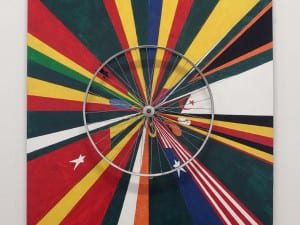Review by Nathan Breeze
The pioneering American engineer Buckminster Fuller once famously asked the question ‘how much does your building weigh?’ This perhaps marked the moment where architects and engineers first started to consider the environmental impact of their buildings. Nowadays concerns about sustainability both in terms of construction and in the maintenance of buildings are defining the construction industry. Had he posed the question in 1982 to the Architects Chamberlin, Powell and Bon, who after 11 years onsite had just completed the Barbican; a mixed-use concrete jungle (and rightly listed cultural treasure) there would no doubt have been some serious head scratching.
By extreme contrast the Barbican’s latest architectural installation entitled Architecture as Air by acclaimed Japanese architect Junya Ishigami weighs a mere 300g. 53 impossibly thin columns support a similarly skinny beam, creating a 3.8 metre high colonnade stretching the length of the Curve gallery. This work is a development of Ishigami’s experimental installation, Architecture as air: study for château la coste, which was first show at the 12th Venice Biennale of Architecture in 2010. After being destroyed by a wondering cat, the installation was awarded the Golden Lion for the best project (for pushing architecture quite literally to its limits) despite lying in spindly pile topped by an apology note.
It is therefore no great surprise that the 15 visitors admitted at any given time are asked to remove their shoes and carefully walk alongside the exhibit. What exactly one is tiptoeing around is not initially clear. As the visitor focuses their eyes on the exhibition thin vertical threads begin to appear before quickly dissolving due to the lack of visual contrast with the white gallery walls. Ignoring the galleries ducts and lighting in the peripheral vision, gradually one begins to pick up the rhythm of the colonnade as well as whisps of the supporting wires that stabilise the columns. Tracing these is impossible, but working down to the floor one can see the wires taped to the floor in 4 places per columns. Initially this suggests there are just 4 wires per column, in reality there are more than 50.
The tape is the only break in the suspension of disbelief; its only role to enable the architect and his team to find the supports again. It is truly astonishing to consider the agonizing intricacy, concentration and superhuman eyesight that have gone into this installation. Looking too hard at the delicate work and it seems to resonate in the surrounding air; Ishigami talks about pursuing an architecture where space and structure cease to be divided. His work combines playful yet simple ideas made possible by rigorous engineering and the controlled manipulation of materials. Reading pages from his book lying at the end of the gallery there are more pages dedicated to calculations and equations than to pretty images and poetic spiel.
Similarly phenomenological was the Balloon project installed in the Museum of Contemporary Art in Tokyo in 2007. An enormous aluminium box weighing 1 tonne was filled with helium and gently floated and bounced around the gallery reflective the sky above. Outside of galleries, his most notable permanent project is KAIT, a new studio on the campu s of the Kanagawa Institute of Technology in Toyko. Used by engineering and design students from the Institute alongside members of the community, this large rectangular structure comprises of a forest of 305 individually and thinly proportioned columns of varying widths and clad in glass.
Nature is a consistent source of inspiration in Ishigami’s work. In Architecture as Air he notes the 0.9mm columns are as thick as raindrops and the 0.2mm tension members are as thick as cloud droplets. By building at the scale of nature he seeks to ‘create through architecture the kind of transparency found in nature that until now, architecture has been unable to provide.’
Refreshingly the installation is so transparent that a camera can’t capture it, hopefully encouraging people to come along and struggle to see for themselves.
Architecture as Air is on display in the Curve Gallery until 16 October.
Aesthetica Magazine
We hope you enjoying reading the Aesthetica Blog, if you want to explore more of the best in contemporary arts and culture you should read us in print too. In the spirit of celebration, Issue 41 includes a piece on Guggenheimn Bilbao where the Luminous Interval features internationally acclaimed artists such as Louise Bourgeois, Kiki Smith and Damien Hirst, ArtAngel’s new commission at MIF, Bruce Nauman’s retrospective at The Kunsthalle Mannheim and Cory Arcangel’s Pro Tools at the Whitney in NYC. You can buy it today by calling +44(0)1904 479 168. Even better, subscribe to Aesthetica and save 20%. Go on, enjoy!
Photo credit: Lyndon Douglas
Courtesy: Barbican Art Gallery





